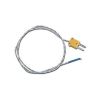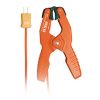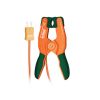Extech SDL400 Light Meter/Datalogger
Features
- Wide range to 10,000Fc or 100kLux
- Stores 99 readings manually and 20M readings via 2G SD card
- Offset adjustment used for zero function to make relative measurements
- Free ground shipping
- Expedited repair and warranty service
- Lifetime technical support
- More
Overview
The Extech Light Meter/Datalogger has a wide range to 10,000Fc or 100kLux and cosine and color-corrected measurements. The meter utilizes precision silicon photo diode and spectral response filter. The datalogger date/time stamps and stores readings on an SD card for easy transfer to a PC. The offset adjustment is used for zero function to make relative measurements.
Data Storage
The datalogger stores up to 99 readings manually and 20M readings via the 2G SD card, and adjustable data sampling rates range from 1 to 3600 seconds. The type K/J thermocouple input is used for high temperature measurements. Additonal meter features include record/recall min and max readings, data hold, and automatic power off with disable function.
- Fc range: 200, 2000, 10kFc
- Fc range resolution: 0.1Fc
- Fc range basic accuracy: ±4%rdg
- Lux range: 2000, 20k, 100kLux
- Lux range resolution: 1Lux
- Lux range basic accuracy: ±4%rdg
- Type K temperature range: -148 to 2372°F (-100 to 1300°C)
- Type K temperature resolution: 0.1°
- Type K temperature basic accuracy: ±(0.4% + 1.8°F/1°C)
- Type J temperature range: -148 to 2192°F (-100 to 1200°C)
- Type J temperature resolution: 0.1°
- Type J temperature basic resolution: ±(0.4% + 1.8°F/1°C)
- Memory: 20M data records using 2G SD card
- Dimensions: 7.2 x 2.9 x 1.9" (182 x 73 x 47.5mm)
- Weight: 16.2oz (475g)
- (1) Datalogger
- (6) AA batteries
- (1) SD card
- (1) Hard carrying case
- (1) Light sensor with protective cover
In The News
Wildfire Prevention in the Sierra Nevada Region with the Yuba Watershed Institute
Though recent wildfires have sparked new conversations about wildfire management and response, groups like the Yuba Watershed Institute have been monitoring the forests and water resources of the Sierra Nevada region for decades, managing approximately 5,000 acres of land with the Bureau of Land Management (BLM) and about 7,000 acres in private land partnerships. The goal of the Institute is to work with local communities and land agencies to improve watershed and forestry management through informed practices and public outreach. The goals of the Yuba Watershed Institute are three-fold: Improve the ability of fire suppression agencies like the California Department of Forestry and Fire Protection ( CAL FIRE ) and the US Forest Service.
Read MoreWave Sensors Integration with NexSens Buoys: A Cutting-Edge Solution for Wave Measurment
Real-time wave data supports accurate weather prediction, safe and efficient maritime operations, and provides valuable safety and operating condition information for recreation and commercial fishing. Understanding wave dynamics also helps with the design of protective coastal structures like seawalls, breakwaters, and jetties. It also supports better prediction of their impact on sediment transport and coastal geomorphology. Wave data is a key factor in qualifying and designing offshore wind farms and harnessing kinetic energy for electrical generation. It helps with the understanding of ocean-atmosphere interactions and contributes to studies of sea-level rise and climate change impacts.
Read MoreSpring 2025 Environmental Monitor Available Now
In the Spring 2025 edition of the Environmental Monitor, we highlight partnerships across the world and the importance of collaboration between government agencies, universities, environmental groups, local communities, and other stakeholders. From great white shark research in Cape Cod to monitoring fisheries in Lake Erie, this latest edition underscores partnerships that connect stakeholders in a watershed through environmental data. With an emphasis on data sharing, a combination of real-time and discrete sampling keeps the public and partners informed of environmental conditions. Our writers also sought out science professionals dedicated to working with peers within and outside of the environmental sector.
Read More













